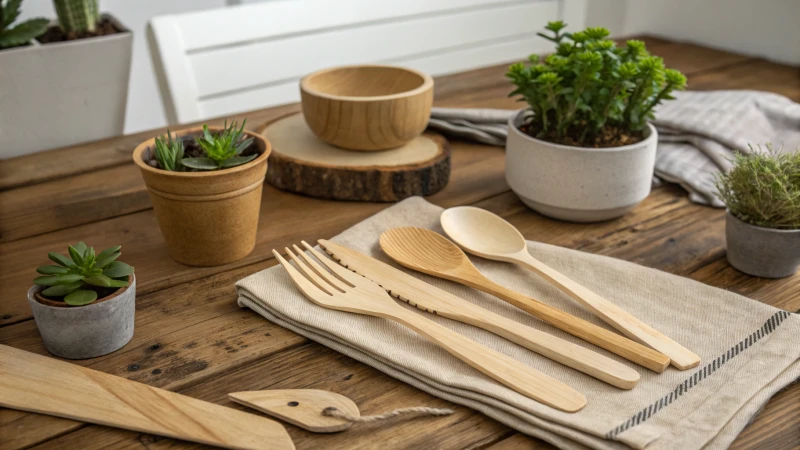
You know that moment when you're trying to make eco-friendly choices, but you’re not sure if they truly help the planet? Let's unravel the mystery of wooden cutlery.
Sustainable wood sourcing for cutlery production means using responsibly managed forests, adhering to certifications like FSC, and minimizing environmental impact through legal harvesting. These practices ensure wooden cutlery is an eco-friendly alternative to plastic.
I remember when I first switched to wooden cutlery in my kitchen. It felt great, thinking I was doing my bit for the environment. But then I started wondering, how do I know this wood is truly sustainable? The key is understanding what goes into sustainable sourcing—like ensuring the wood comes from responsibly managed forests and carries certifications such as the Forest Stewardship Council (FSC). It's also about legal harvesting practices that don't harm the environment. By choosing suppliers who adhere to these standards, I found peace of mind knowing my wooden cutlery is genuinely eco-friendly.
FSC certification guarantees sustainable wood sourcing.True
FSC certification ensures wood is harvested responsibly, preserving ecosystems.
All wooden cutlery is more eco-friendly than plastic.False
Only sustainably sourced wooden cutlery is eco-friendly; others may harm forests.
How Can Wood Sourcing Be Truly Sustainable?
Imagine a world where every piece of wood you use helps nurture the planet rather than harm it. Sustainable wood sourcing can make that dream a reality.
Sustainable wood sourcing ensures forests are responsibly managed, protecting biodiversity and supporting local communities. It involves certification systems like FSC, legal compliance, and maintaining ecological balance.
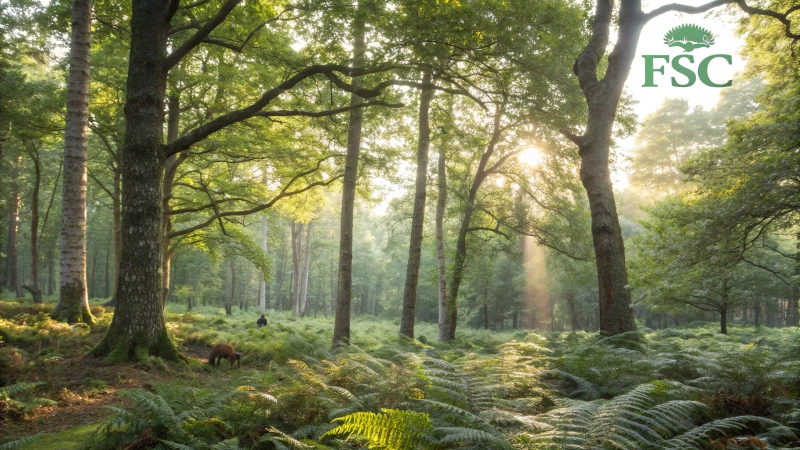
Key Certifications in Sustainable Wood Sourcing
When I first started my journey into sustainable sourcing, I was amazed at how certifications could transform industries. The Forest Stewardship Council (FSC)1 certification quickly became my beacon. It guarantees that the wood products I choose come from forests that are not only responsibly managed but also bring about environmental, social, and economic benefits. Then there's the Programme for the Endorsement of Forest Certification (PEFC), which reassures me that sustainable forest management standards are being met worldwide.
| Certification | Description |
|---|---|
| FSC | Ensures environmental, social, and economic benefits. |
| PEFC | Promotes sustainable forest management globally. |
Legal Harvesting Practices
I once worked on a project where we uncovered illegal logging in a beautiful forest area. It was a turning point for me. Legal harvesting is not just a bureaucratic box to tick; it's crucial for sustainability. By adhering to national and international laws, like the Lacey Act2 in the U.S., we actively combat illegal logging, a major threat to forests globally.
Maintaining Ecological Balance
I remember walking through a forest where selective logging was practiced—it felt as if nature itself was flourishing around me. Maintaining the ecological balance of forests means engaging in practices like selective logging to minimize ecosystem damage. By preserving biodiversity and supporting the forest's natural regeneration, we ensure these majestic lands thrive.
Community and Economic Benefits
Reflecting on the times I've visited communities reliant on forestry, it's clear that sustainable wood sourcing must uplift these communities economically and culturally. Programs like Community Forest Management3 empower locals by involving them directly in managing their resources.
- Social Benefits: Empowering communities through direct involvement.
- Economic Growth: Providing jobs and supporting local economies.
Recognizing Eco-Friendly Products
Whenever I'm shopping for wood products, I look for certified labels—it's become second nature. Retailers like IKEA4 have made commitments to source more sustainably by 2030, setting a benchmark for us all. Understanding these practices helps me make informed decisions that align with my environmental values.
By focusing on these aspects, not only do I contribute to a healthier planet, but I also meet my wood needs sustainably—ensuring future generations can enjoy our planet’s natural beauty just as we do today.
FSC certification ensures sustainable wood sourcing.True
FSC certifies wood from responsibly managed forests, ensuring sustainability.
Illegal logging is not a threat to global forests.False
Illegal logging poses significant threats to forests worldwide, affecting ecosystems.
How Does Forest Certification Ensure Eco-Friendliness?
Ever wondered how your wooden spoon might be saving the planet?
Forest certification ensures eco-friendliness by establishing benchmarks for sustainable forestry practices, safeguarding biodiversity, and advocating responsible land use. Certified forests adhere to guidelines that reduce environmental harm while preserving ecosystem integrity.
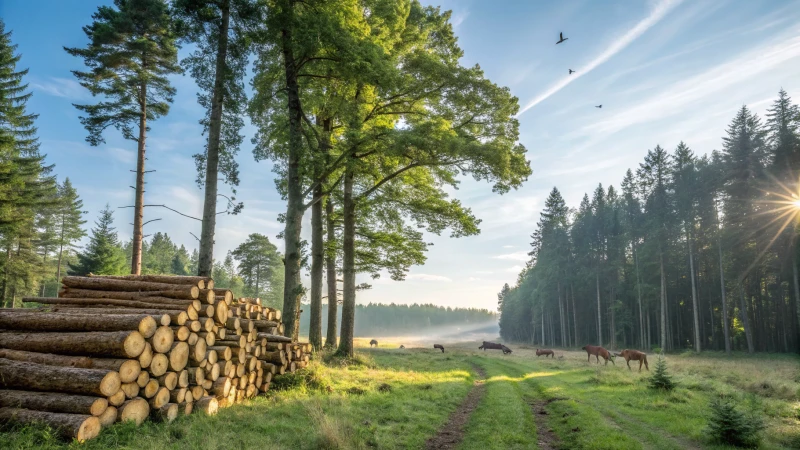
Understanding Forest Certification
Forest certification is like having a trusted friend vouch for your eco-choices. It evaluates and validates forest management against established environmental standards5 we can trust. This system is all about promoting responsible forestry, much like how I try to choose the right products when shopping—ensuring that what I pick respects nature.
Principles of Sustainable Forestry
At the heart of forest certification are principles designed to tread lightly on the earth. Imagine walking through a forest where every tree feels like it’s thriving. These principles ensure that ecosystems remain healthy and diverse, laws are respected, and harvesting is done sustainably. I once visited a certified forest and saw firsthand how they limit harmful chemicals6, protecting the wildlife and waterways that make these places magical.
| Principle | Description |
|---|---|
| Biodiversity | Protects wildlife habitats and promotes species diversity |
| Sustainable Harvesting | Limits logging to maintain forest regeneration |
| Legal Compliance | Ensures adherence to environmental laws |
Impact on Supply Chains
Forest certification doesn’t just stop at the forest’s edge; it ripples through global supply chains. More and more, consumers like us are demanding products that reflect our values. I recently learned about companies like WonBon7 who source certified timber to ensure their products are as green as they promise. This shift towards certified goods helps drive broader adoption of sustainable practices.
Certification Bodies: FSC and PEFC
When it comes to overseeing forest certification, two main bodies stand out: the Forest Stewardship Council (FSC) and the Programme for the Endorsement of Forest Certification (PEFC). These organizations set the frameworks for evaluating forest management in eco-friendly terms. I’ve come to appreciate how the FSC takes a global approach while the PEFC tailors standards regionally, making them relevant wherever you are.
Benefits of Certification
- Environmental Protection: Certification ensures that forests are managed sustainably, preserving biodiversity.
- Market Access: Products with certification often gain entry into premium markets focused on sustainability.
- Community Engagement: It encourages local communities to take part in forest management, much like how I involve my neighborhood in local clean-up events.
By getting to know these elements, I’ve come to see how forest certification forms a backbone of eco-friendly forestry practices and related industries8. This knowledge has inspired me to make more informed choices, knowing I'm supporting something bigger than myself.
Certified forests limit chemical use harmful to wildlife.True
Certified forests implement practices to reduce chemical usage, protecting ecosystems.
FSC and PEFC are the only forest certification bodies worldwide.False
While FSC and PEFC are major bodies, other regional certifications exist.
What Are the Legal Requirements for Harvesting Wood?
Navigating the maze of wood harvesting laws can feel like trying to solve a puzzle in the dark. But with the right guide, you’ll not only avoid legal hiccups but also help keep our forests thriving.
To legally harvest wood, it's essential to secure permits, follow sustainable practices, and respect protected areas. Regulations vary by region, so checking with local authorities is crucial before starting any wood harvesting project.
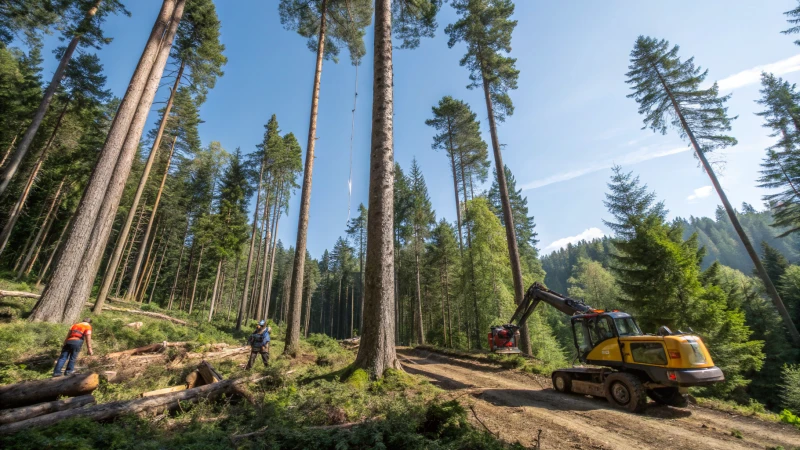
Understanding Permits and Licenses
I remember my first foray into wood harvesting. It was an autumn morning, crisp and promising, and I was eager to collect firewood for the upcoming winter. However, I soon realized that my enthusiasm alone wouldn't cut it—I needed the right permits. These permits are not just bureaucratic hurdles; they're vital for ensuring our activities align with regional laws and support sustainable forest management. For personal use, obtaining a permit might be relatively straightforward, but it's essential to be aware of restrictions on how much and what type of wood you can harvest.
Regional Regulations and Guidelines
Every region has its own rules, which can feel overwhelming. I once spoke with a friend who lives near a national forest in the United States. He shared how the U.S. Forest Service requires specific permits even for cutting firewood on public land—something I wasn't aware of until then. In Europe, things can be even more intricate, often involving adherence to detailed forest management plans9 that guide sustainable practices. It's always best to touch base with local authorities or forestry departments to fully grasp these guidelines.
| Region | Permit Type | Key Restrictions |
|---|---|---|
| United States | Personal & Commercial | Limits on volume, type of trees |
| Europe | Varies by country | Requires forest management plans |
Sustainable Practices
I’ve learned that sustainability is at the core of legal wood harvesting—it's not just about taking what you need but doing so in a way that supports the forest's long-term health. Practices like selective cutting can make a significant difference. Certification programs such as FSC10 and PEFC play an essential role here, ensuring that the wood we use is sourced responsibly.
Protecting Biodiversity
It's easy to overlook how important it is to respect protected areas. These zones are crucial for preserving biodiversity and maintaining ecological balance. I once joined a local conservation group on a trek, and seeing firsthand the vibrant ecosystems thriving in untouched areas left a lasting impression on me. As responsible harvesters, we must understand and abide by these restrictions.
Enforcement and Penalties
Nobody wants to face hefty fines or other penalties, which is why understanding and following legal requirements is so important. Local enforcement agencies are diligent in monitoring wood harvesting activities to ensure compliance with the law. This vigilance underscores the need for proper documentation before embarking on any wood harvesting venture.
Permits are required for personal wood harvesting in the U.S.True
The U.S. Forest Service mandates permits for cutting firewood on public land.
In Europe, all countries require forest management plans.False
European regulations vary by country; not all mandate forest management plans.
Why Should You Choose Wooden Cutlery Over Plastic?
Ever found yourself pondering over the choice between wooden and plastic cutlery? You're not alone. This simple decision can make a big impact on our planet and dining experiences.
Wooden cutlery is a better choice than plastic because it's biodegradable, produced sustainably, and offers a pleasing aesthetic. Unlike plastic, wooden utensils decompose quickly, minimizing waste and promoting eco-friendly habits.
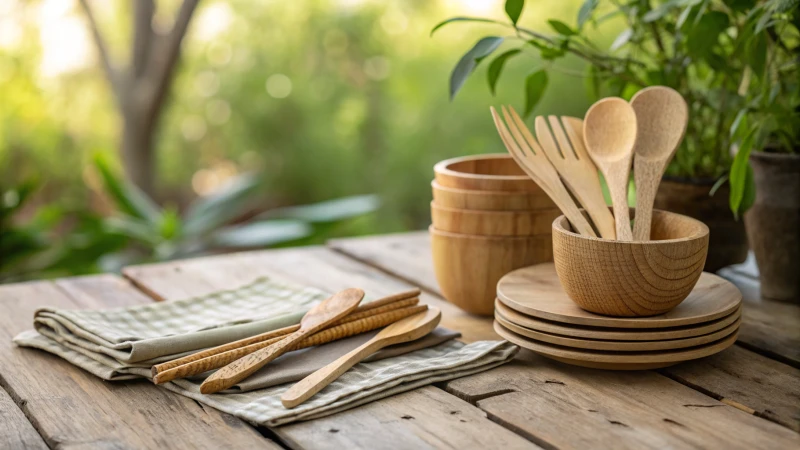
Biodegradability: A Key Advantage
I remember the first time I truly realized the impact of my choices on the environment. It was during a beach clean-up event where I saw firsthand the massive amount of plastic waste littering our shores. That’s when it hit me—choosing wooden cutlery isn’t just about aesthetics; it's about making a real difference. Unlike plastic, which stubbornly lingers for centuries, wooden utensils break down in just months, leaving minimal impact on our beautiful planet. This simple switch can help reduce landfill waste significantly and support a more sustainable environment11. For someone like me who’s committed to reducing my ecological footprint, this makes all the difference.
| Feature | Wooden Cutlery | Plastic Cutlery |
|---|---|---|
| Decomposition Time | Months | Hundreds of years |
| Environmental Impact | Minimal | High |
Eco-Friendly Production
When I decided to switch to wooden cutlery for my small catering business, I was impressed by the sustainability of its production. Often made from sustainably sourced wood, these utensils don't contribute to deforestation or habitat loss. As I strive to align my business with green practices, opting for wooden cutlery perfectly matched my sustainability goals12.
Aesthetic and Practical Appeal
Wooden cutlery doesn’t just help the planet—it enhances the dining experience, too. I find that its natural look adds a touch of elegance to any setting, whether it’s a rustic picnic or an upscale dinner. It's sturdy and versatile, perfect for various foods without the worry of harmful chemicals leaching into meals like some plastics do.
Health Considerations
I was genuinely concerned about the health implications of microplastics in our food. Learning that wooden cutlery doesn’t pose this risk was a game-changer for me. Switching to wooden utensils became a no-brainer, especially as I aim to support healthier lifestyles13 for my family and customers.
Market Trends and Consumer Preferences
As more people become aware of environmental issues, I've noticed a significant shift in consumer preferences toward sustainable products. Businesses that embrace wooden cutlery are viewed as forward-thinking, which not only boosts their brand reputation among eco-conscious customers but also gives them a competitive edge in an increasingly green market. In choosing wooden over plastic, I feel like I'm not just keeping up with trends—I'm part of a movement towards a better future.
Wooden cutlery decomposes faster than plastic.True
Wooden cutlery decomposes within months, while plastic takes hundreds of years.
Plastic cutlery is more eco-friendly than wooden cutlery.False
Plastic has a high environmental impact, unlike the minimal impact of wooden cutlery.
Conclusion
Sustainable wood sourcing for cutlery involves responsible forest management, certifications like FSC, and legal harvesting practices, ensuring eco-friendly alternatives to plastic while supporting biodiversity and local communities.
-
Explore FSC certification for insights into responsible forest management and how it ensures wood is sustainably sourced. ↩
-
Discover how the Lacey Act combats illegal logging and supports sustainable forestry practices. ↩
-
Learn about Community Forest Management and how it supports local communities while promoting sustainable forestry. ↩
-
Understand IKEA's commitment to sustainable wood sourcing and how it impacts their product offerings. ↩
-
Discover the key environmental standards that underpin forest certification for sustainable practices. ↩
-
Learn how certified forests control chemical use to protect ecosystems. ↩
-
Explore WonBon's dedication to sourcing from certified forests for eco-friendly products. ↩
-
See how various industries incorporate certified materials into their supply chains for sustainability. ↩
-
Learn about the requirements of forest management plans across European countries. ↩
-
Discover how FSC certification supports sustainable forestry practices globally. ↩
-
Explore how wooden cutlery's biodegradability and production reduce environmental impact. ↩
-
Learn about certifications that ensure wooden cutlery is sourced sustainably. ↩
-
Understand how wooden cutlery can reduce exposure to harmful microplastics. ↩

